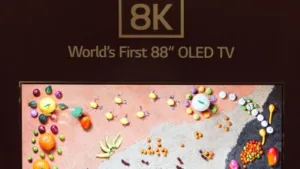LG did not hold a conference, although two executives did give a keynote, focusing on the ThinQ AI technology.
After an introduction that hyped up IFA, and covered some of the area that was talked about at the IFA opening press event, LG came on. There were two speakers and Jo Seong-jin, the company’s vice chairman and CEO of LG Electronics spoke first. Jo started his career with LG forty two years ago and he said his aim is to “make the best products in the world”. Innovation, he said, is to make life better, not just to develop technology.
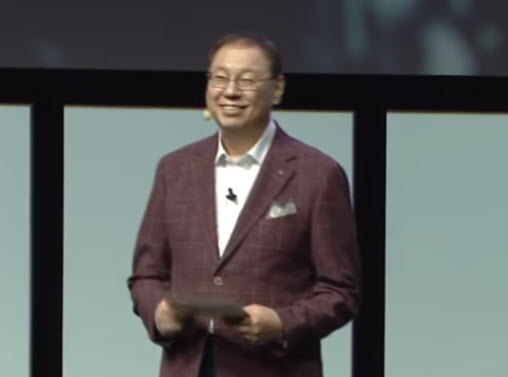 LG’s Seong-jin Jo
LG’s Seong-jin Jo
Combined with 5G and cloud technology, AI will change many things in the home, for example, by knowing about your day at work. The fridge will tell the car what needs buying at the store (Regular readers know I’m somewhat sceptical about this – Man. Ed.)
Evolve, Connect and Open
Jo then brought Dr I.P. Park, the LGE President and CTO onto the stage. He said that AI will bring fundamental change in how we live our lives. He said LG’s approach is based on three words “Evolve, Connect and Open”. A video showing an intelligent robotic vacuum cleaner with facial recognition and an air conditioner that responds to the movement of individuals was then presented under the ‘Evolve’ theme. Interaction with users will be a critical part of the evolution, Park said.
 LG’s Dr. I.P. Park
LG’s Dr. I.P. Park
In the analogue age, products such as vinyl records degraded, but MP3’s don’t depreciate (although hi-fi buffs might say that they start by being degraded! Man. Ed). Park said that digital products should learn about their own usage and become more valuable over time as more is understood. Edge computing need to be evolved to add to the power of the cloud. Park said that LG has been developing its own deep learning technology with a range of start-ups and universities.
Dr Andrew Ng is founder and CEO of Landing AI and when he came on for a brief appearance he said that makers would have to transform with AI, as they had to with the internet. Inexpensive sensors have enabled the collection of a lot of data. He said that in the future, it will be unthinkable to buy CE products and appliances that are not AI-enabled.
Connect
Under the ‘Connect’ theme, Park showed a video of voice, via a smartphone, was used to adjust, for example, the heating and lighting automatically. There was also a video showing robots for hospitality, wayfinding in stores and cleaning. Connectivity should allow the benefits of AI, wherever you are. Park said that in Israel in May, a home vacuum took photos of a burglar and the burglar ran away immediately. Could the vacuum cleaner have prevented the break-in? Each device can have an ‘infinite potential’.
LG products are Wi-fi enabled and controlled by LG’s ThinQ app. Park brought on LG Cloi, a robot for wayfinding that supports voice recognition.
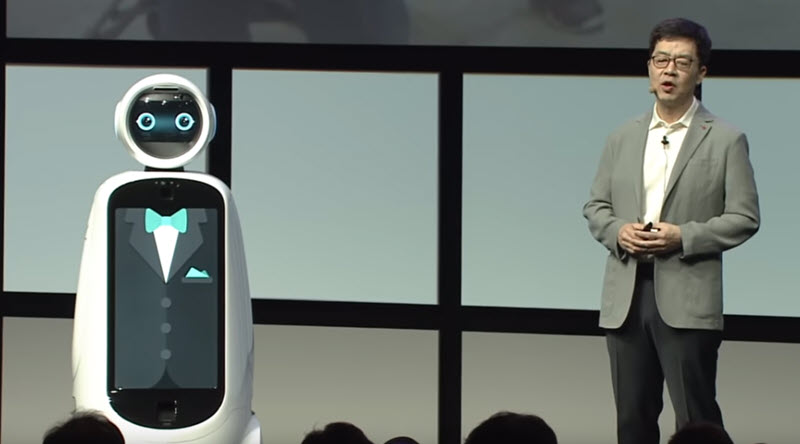 LG’s Kloi Wayfinding Robot
LG’s Kloi Wayfinding Robot
Park said that LG is working on using 5G to allow control of the home from a car. B2B products will also benefit from AI. Park introduced Dr. Matthew Perry of the Open Connectivity Foundation. The OCF wants to make the AI experience as seamless as possible and has 400 members. The OCF has ‘a single language’ to all interconnectivity between devices. There is a new collective commitment from LG, Samsung, Haier and Electrolux to get things to work together.
The next video showed how appliances might recommend clothing and help with purchasing and other activities such as finding old photos.
Open
Turning to the ‘Open’ topic, Park said that the world is too complex and diverse for one company to meet everybody’s needs and so LG works with many big companies. WebOS is LG’s software for devices and is both compatible with the OCF specification and is now open sourced so other companies can use it. WebOS can work in a TV to show, for examples, photos from Google Photos and a demonstration of the use of voice was given. Park said that the user just wants a great experience and doesn’t care which company delivers it.
Dr. Peter Kuerpick from Here said that his company has developed a location-based platform and the technology is in 80% of in-car navigation in Europe and the US. Cars will collect huge amounts of data, but the question is how to derive value from the data. Location is a driving element in every business – even in a hospital, it may be important to know where some special equipment is.
Cars produce, currently, around 2,500 data streams – they are much more complex than smartphones and a lot can be done with that data. Here works with, for example, BMW and Mercedes. Here has worked with LG for the Cloi product for very precise locations and it has a platform where data can be related to location data.
Dr Kyungchul Kong from SK Robotics came on to show a new wearable exoskeleton technology that can help those that have trouble walking. The aim is make the user feel stronger and lighter, but the system needs to work naturally for the user. The robot is useful enough to kick a ball and Kong demonstrated it by kicking a ball into the audience.
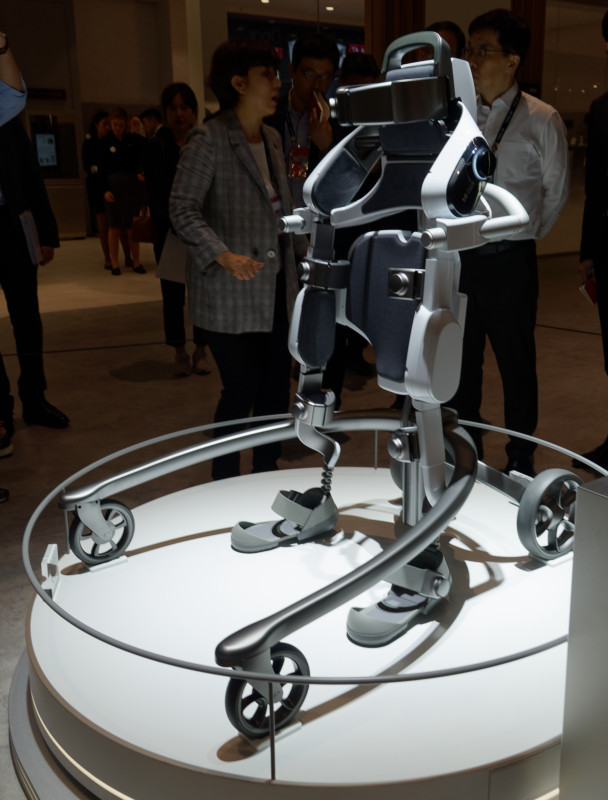 LG had a lot of robots and this exo-skeleton. Image:Meko
LG had a lot of robots and this exo-skeleton. Image:Meko
Park then signed off by highlighting the three “Evolve, Connect and Open” topics.
Booth Tour
LG opened up its booth before the opening to the public. There was a big new OLED canyon demo that was, as always, impressive.
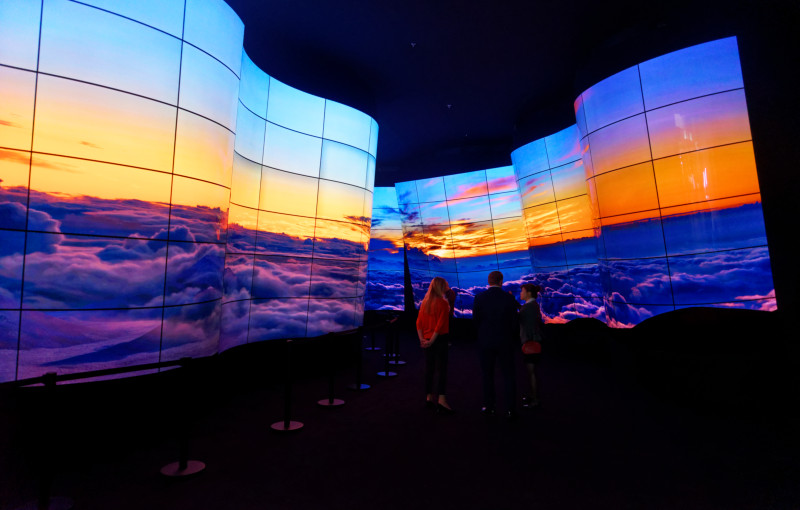
OLED is, of course, LG’s key TV technology and on display was an 88″ 8K OLED that was being shown as a set for the first time, although LG Display has previously shown the panel. However, there were few technical details partly because the set is not yet a final product and LG told us that it currently does not have a target date for shipping, as it doesn’t see the market as ready. (and I wonder about the yield it could achieve on the panel! Man. Ed.)
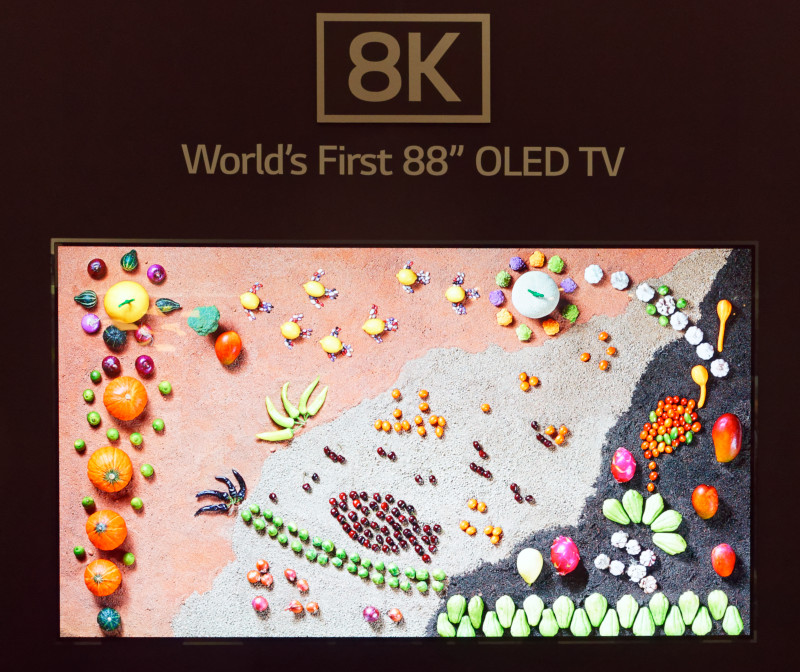 LG Showed this 8K prototype – ready, but no date for launch, yet. Image:Meko
LG Showed this 8K prototype – ready, but no date for launch, yet. Image:Meko
Also shown just as a concept was the 173″ LED which had UltraHD resolution (which makes it almost exactly 1mm pitch). A UK journalist that I was looking at the LED alongside asked “Why do they make it look so horrible?”. He was right, the LED had way too much saturation and looked very unnatural. Nevertheless, some viewers seemed to be impressed.
 We thought LG’s response to Samsung’s ‘The Wall’ looked over-saturated. Image:Meko
We thought LG’s response to Samsung’s ‘The Wall’ looked over-saturated. Image:Meko
So there were no new TVs at the event, but we did find some new projectors. The CineBeam HU80KSW is a follow on to the HU80KG which is based on a 2,500 Ansi lumen DLP engine with a laser phosphor light source. The CineBeam can be used in a direct projection mode, but is also fitted with a mirror to allow projection at right angles. The mirror is flat, so it does not turn the unit into a UST configuration. The zoom ratio is 1.2:1 and throw ratio is 1.3 to 1.56. The brightness is rated to be enough for a 150″ image and contrast is quoted at 150,000:1. There are dual HDMI inputs, dual 7W speakers and the unit will sell for €2,699.
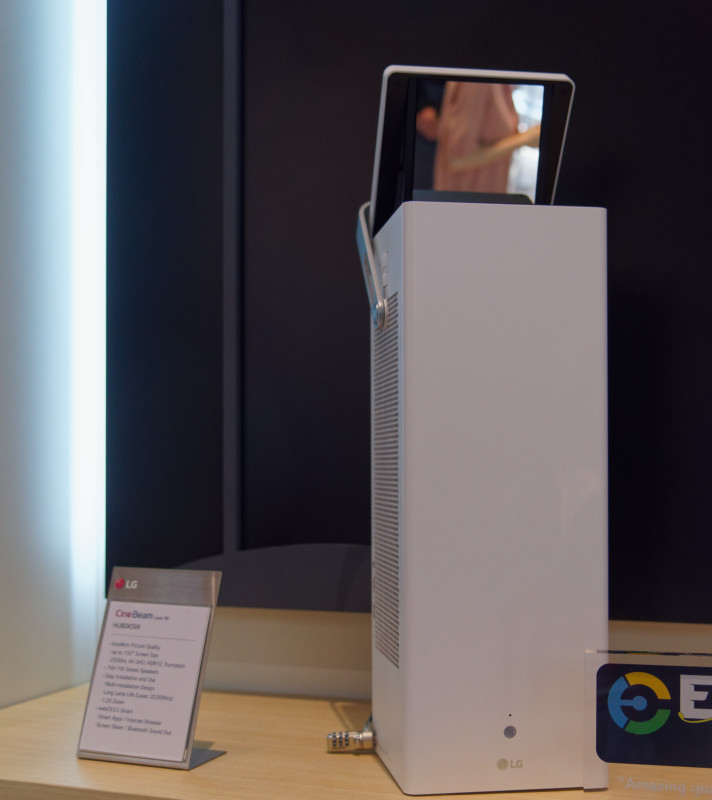 The CineBeam projector can use the mirror to deflect the image beam. Image:Meko
The CineBeam projector can use the mirror to deflect the image beam. Image:Meko
In the monitor area, gaming was the focus and the 34KG950G, a high end ‘UltraGear’ monitor that is due to be shipped at the end of November for €1,399. Features include G-Sync and the monitor is claimed to have a 1ms GtG response time with 100Hz refresh (and 120Hz when ‘over-clocked’). The curved unit has 3440 x 1440 resolution (21:9) and colour coverage is 98% of DCI-P3, using the nano-cell IPS technology (and 135% of sRGB). Inputs include DisplayPort and HDMI.
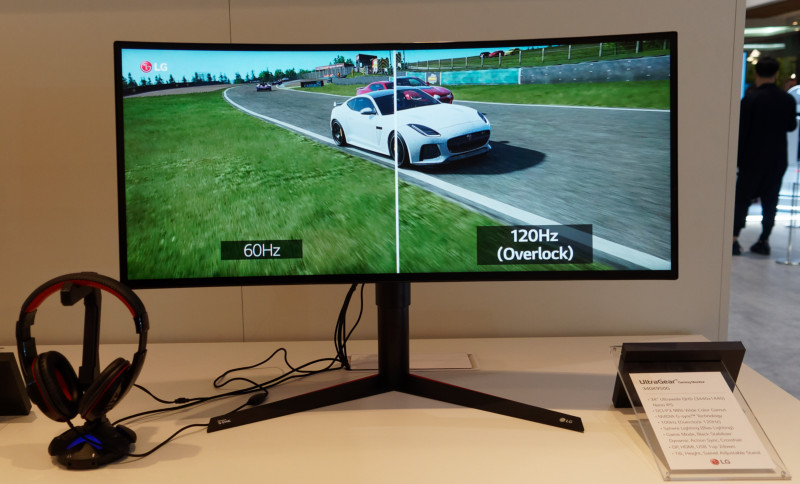 The new gaming monitor can be overclocked. Image:Meko
The new gaming monitor can be overclocked. Image:Meko
The 34WK95U is a flat monitor supports Type-C USB (Thunderbolt 3) and can supply 85W using USB Power Delivery. It has been shown since CES and is expected to start shipping ‘shortly’, but pricing, we were told, is still to be decided. (We think that 34″ 21:9 is too wide to be flat for a monitor, but we suspect that at the smaller pitch, there are too many challenges to achieve good quality and reasonable power consumption.
The monitor is ‘calibration ready’ and supports 98% of DCI-P3 and is DisplayHDR 600 certified. There are dual 5W speakers and an adjustable stand.
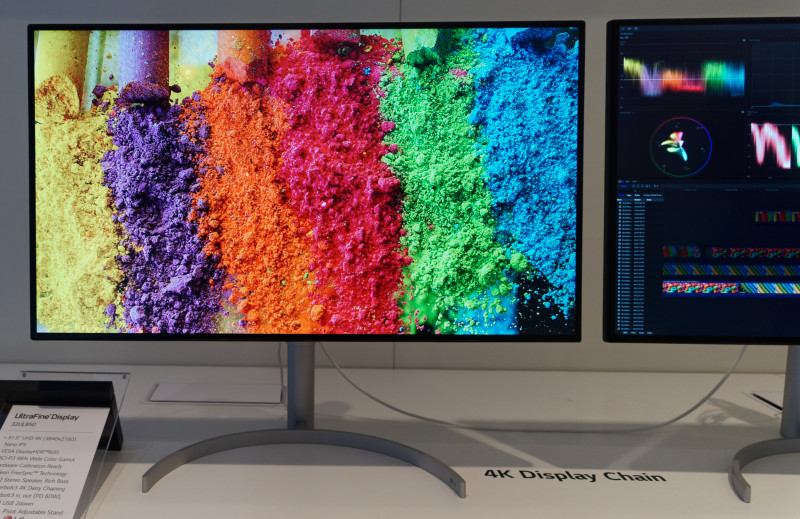 The new 32″ monitor uses an IPS NanoCell panel. Image:Meko
The new 32″ monitor uses an IPS NanoCell panel. Image:Meko
The 32UL950 has an UltraHD panel with Nano IPS technology and is also DisplayHDR 600 certified and ‘calibration ready’. The monitor also supports FreeSync and Thunderbolt 3, but with 60W of charging power. Features include height adjustment and a pivot stand. Our notes said that it ‘looked good’ and LG was showing how the Thunderbolt 3 connection could be used to ‘daisy-chain’ multiple monitors.
Mobile Phones
LG was showing its G7 ThinQ phone, which, unlike many flagship smartphones these days, has an IPS LCD which is capable of producing up to 1,000 cd/m² and uses an RGBW architecture to get to that level of brightness.
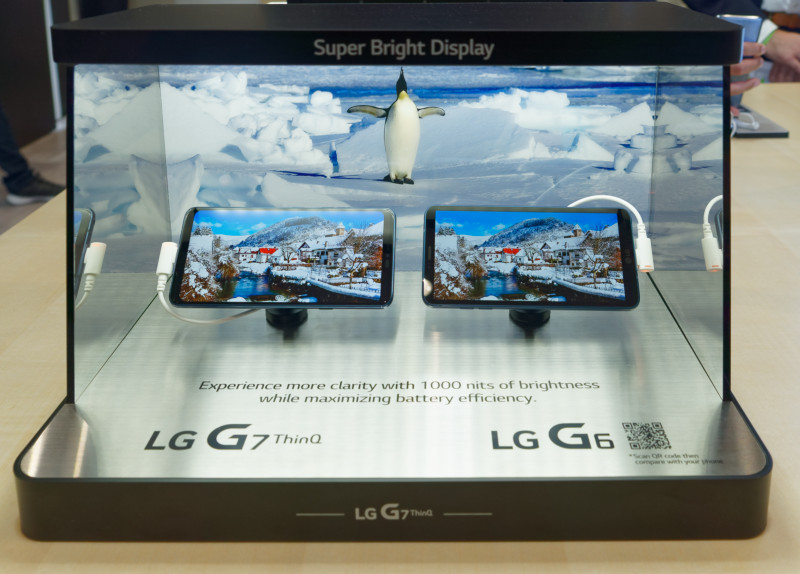 LG was demonstrating the very high brightness from the LG G7 ThinQ smartphone. Image:Meko
LG was demonstrating the very high brightness from the LG G7 ThinQ smartphone. Image:Meko

